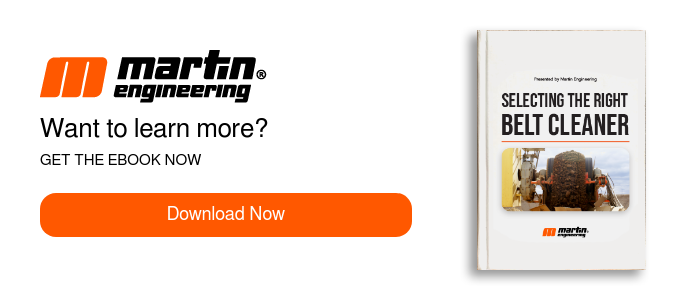The Evolution Of Belt Cleaning Solutions
From Homemade Fixes to Advanced Solutions
For many years, homemade belt cleaners—often improvised from rubber slabs, used belting scraps, or discarded lumber—were commonplace. These makeshift solutions proved unwieldy, cumbersome, and generally ineffective. However, as plant operations demanded wider, faster, and more heavily-loaded conveyors with deeper troughs, the need for engineered belt-cleaning systems became paramount. These systems, comprising a mainframe, cleaning blade, and tensioner, were developed to safeguard plant investments by prolonging the service life of costly belts and conveyor components. 
Engineered systems streamline maintenance with simplified blade replacements and incorporate advanced materials like plastics, ceramics, and tungsten carbide to extend blade life and minimize upkeep. By optimizing blade design and tensioning mechanisms, these systems significantly enhance cleaning performance, effectively removing fine particles and moisture adhered to the return side of belts.
Monitoring Cleaner Performance
The ability to measure carryback facilitates the development of performance specifications tailored to each material-handling facility and bulk material. These specifications define acceptable carryback levels, which suppliers must adhere to during design, installation, and maintenance of belt-cleaning systems.
Following installation, carryback tests are essential to evaluate system performance. Regular testing and record-keeping provide crucial insights into maintenance needs and opportunities for system upgrades, offering facilities valuable data to assess potential cost savings from more efficient cleaning solutions. Despite the challenges faced by facilities, prioritizing performance analysis and maintenance programs can optimize investments in belt-cleaning equipment, often best achieved through service contracts with specialized providers.
Multiple belt cleaner systems take into consideration the dynamics of the surface of the belt and the nature of the material as it passes around the head pulley.
Designing Conveyors for Effective Cleaning
When planning new conveyor systems, specifying belt-cleaner performance criteria is essential. These criteria should include maximum allowable carryback measured in grams per square meter (oz/ft2) passing through the cleaning system. Engineers and plant owners must collaborate to ensure conveyor systems are equipped with adequate cleaners to maintain carryback levels below contractual limits. Design considerations should include sufficient space for installation and maintenance of belt-cleaning systems, incorporating components compatible with effective belt cleaning goals.
Insufficient space for multiple belt-cleaner systems in head frames and housings is a common issue, often due to oversight of material characteristics in their worst conditions. Designing for clearance and access according to Conveyor Equipment Manufacturer’s Association (CEMA) guidelines is crucial, and the design should allow the belt-cleaner manufacturer to fit and mount the appropriate system, including cutting the holes in the chute after erection and belt installation.
Effective belt cleaning hinges on matching blade profiles to belt surfaces. Smooth operation requires avoiding obstacles such as wing pulleys, out-of-round pulleys, or poorly installed lagging, which hinder blade contact and diminish cleaning efficiency, potentially shortening belt lifespan. Vulcanized splices are preferred for optimal belt-cleaning performance, as improperly installed mechanical fasteners can disrupt cleaner operation by causing vibration or “chatter.” Recessing mechanical splices as per manufacturer recommendations mitigates damage to both cleaner and splice.
Following installation, periodic inspection, adjustment, and maintenance are required to maintain cleaning effectiveness. Just as cleaners are engineered for durability and ease of maintenance, conveyor designs should prioritize accessibility, ensuring required clearances for seamless service and upkeep.
